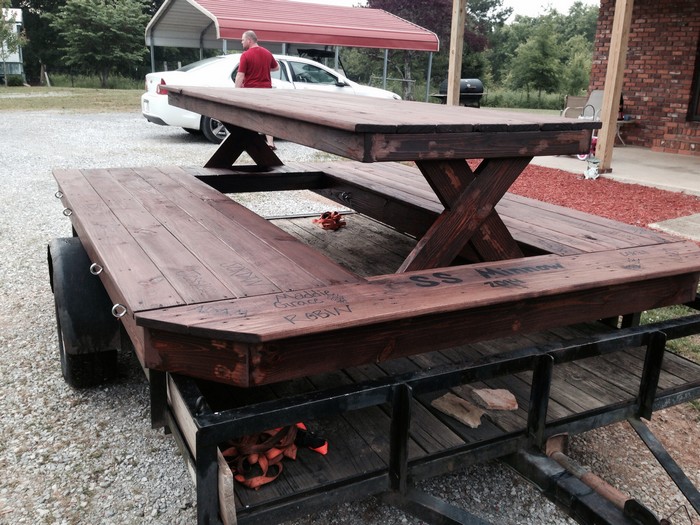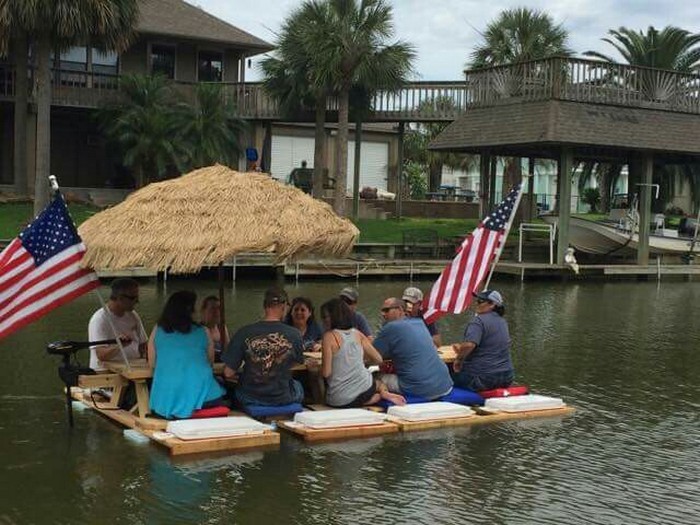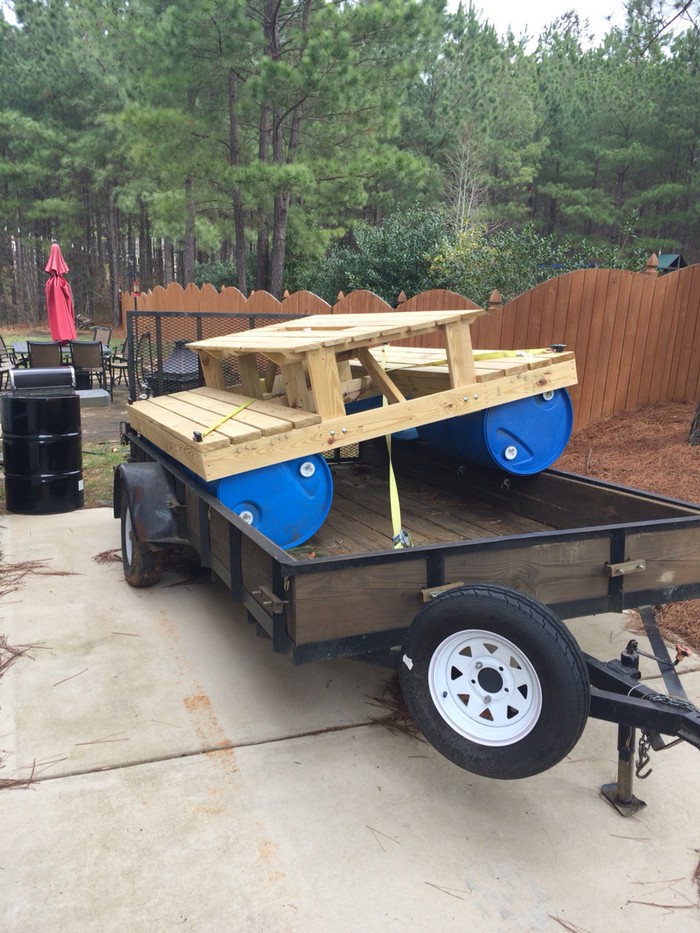Last Updated on March 21, 2024 by teamobn

A picnic is always fun, but it’s just amazing on the lake! During the afternoon or sunset, you’ll enjoy a magical moment picnicking on the water with your friends and loved ones. The best part is that you can pack up a basket with your favorite picnic foods and drinks, and enjoy them while enjoying the stunning views.
No, you don’t need a boat to enjoy a day on the water. Why buy a costly boat when you can DIY a floating picnic table? It’s easy to build and an extraordinary way to spend time on the lake! Plus, it’s a great conversation starter – everyone will ask where you got such a unique floating picnic table!
This clever mechanism has many great features that make it a desirable addition to any household. It serves as a picnic table and a pontoon simultaneously, meaning you can enjoy dining al fresco even when there’s a gentle breeze or chop on the water. It’s perfect for lazy days spent lounging by the pool or at the lake, and is sure to become a firm favorite with friends and family alike.

Contents
Building a Floating Picnic Table
Materials
- 55-Gallon Closed-Head Plastic Drums
- 2×6 Timber
- Decking Joists
- L-Bracket Corner Braces
- Deck Screws
- Cotter Pins
- Wood Glue
Tools
- Measuring Tape
- Miter Saw
- Sander
- Cordless Drill
- Wood Clamp
Instructions
Step 1: Planning and Design
- Decide on the dimensions of your picnic table. A standard size could comfortably seat six people.
- Sketch your design, noting the dimensions for the tabletop, seats, and the support structure.
Step 2: Building the Tabletop and Seats
- Cut the 2×6 timber to your desired length for the tabletop and seats using the miter saw.
- Sand the cut pieces to smooth out rough edges and surfaces.
- Assemble the tabletop and seats by laying out the planks side by side. Use wood glue between each plank for additional stability.
- Secure the planks together using wood clamps until the glue dries. Then, reinforce with decking screws drilled in from the underside.
Step 3: Constructing the Frame
- Using the decking joists, construct a rectangular frame that will fit under the tabletop for support.
- Attach the frame to the underside of the tabletop using wood screws.
- For the seats, create support frames and attach them to the sides of the main frame, ensuring they are level with the tabletop edge.
Step 4: Adding Flotation Devices
- Position the 55-gallon drums under the frame at each corner. These will act as flotation devices.
- Secure each drum to the frame using L-bracket corner braces. Ensure the brackets are tightly screwed into both the drum and the frame.
- For added security, drill holes through the frame and into the drums (be careful not to puncture the closed head) and insert cotter pins.
Step 5: Final Assembly and Safety Checks
- Attach the seats to the support frames on either side of the table. Ensure they are securely fastened and stable.
- Perform a safety check on all screws, braces, and joints to ensure everything is tight and secure.
- Test the table on shallow water to ensure proper balance and buoyancy. Adjust the positioning of the drums if necessary to achieve stability.
Step 6: Finishing Touches
- Sand the entire table to remove sharp edges or rough areas, focusing on the tabletop and seats for a smooth finish.
- You may choose to treat the wood with a waterproof sealant to extend its lifespan and protect it from water damage.
Click on any image to start the lightbox display. Use your Esc key to close the lightbox.![]()












Safety Measures and Regulations
When enjoying the serene beauty of a lake or river aboard a floating picnic table, it’s crucial to prioritize safety for all passengers and comply with local regulations. Floating picnic tables offer a unique way to enjoy water environments, but their safety depends on proper construction, usage, and adherence to guidelines designed to protect everyone on the water.
Construction Safety
- Materials and Design: Ensure your floating picnic table is built with durable, water-resistant materials designed for water stability. It should accommodate the intended number of passengers without compromising buoyancy or balance.
- Secure Assembly: All components of the floating picnic table, including seating and flotation devices, must be securely attached. Regularly inspect screws, brackets, and other fastenings for signs of wear or corrosion.
Personal Safety
- Life Jackets: Always have enough life jackets for everyone aboard the floating picnic table. Even if swimmers are confident, unexpected situations can arise that necessitate using a life jacket.
- Swimming Skills: All users of the floating picnic table should have basic swimming skills. In case someone falls into the water, being able to swim can prevent accidents and ensure a safe return to the picnic table.
- Sun Protection: Sunburn will ruin anyone’s week after dining and having fun at a lake. Lather sunscreen or wear the right gear to prevent UV rays from frying your skin. Look for lotions with a sufficient SPF rating that will provide enough protection from the sun.
Environmental Considerations
- Respect Wildlife: Use the floating picnic table to avoid disturbing local wildlife or damaging their habitat. Avoid littering and dispose of all waste properly to keep waterways clean.
- Noise Pollution: Keep noise levels down to avoid disturbing other water users and wildlife. Enjoy the tranquility of your surroundings without impacting the peace of others.
Legal Regulations
- Permits and Permissions: Before launching your floating picnic table, check with local authorities for any required permits or specific regulations. Some areas may restrict the size or type of floating structures allowed.
- Navigational Rules: Familiarize yourself with the nautical rules of the waterways where the floating picnic table will be used. This includes understanding right-of-way rules, speed limits, and designated areas for specific activities.
- Alcohol Consumption: If alcohol is consumed on the floating picnic table, it’s important to do so responsibly. The person responsible for navigating the table should abstain from alcohol to ensure the safety of all passengers.
- Safety is paramount when enjoying the unique experience of a floating picnic table. By following these guidelines and local regulations, you can ensure a fun and safe outing for everyone involved.
Seasonal and Night-Time Use
Adapting your floating picnic table for seasonal and night-time use extends its utility and opens up new possibilities for adventure and relaxation on the water. Below are ways you can further enjoy your floating dining area.
Adapting to Seasonal Changes
- Summer Enjoyment: The summer season is ideal for floating picnic table outings. Consider adding a lightweight, removable canopy or umbrella for shade to enhance comfort during these warm months. Additionally, portable fans and coolers can keep you and your refreshments cool.
- Autumn and Spring Use: Warm becomes a priority as temperatures drop in autumn and spring. Equip your floating picnic table with portable heaters safe for outdoor use and bring along blankets for extra warmth. Waterproof covers can protect against unexpected rain showers.
- Winter Considerations: In regions where winters are mild, floating picnic tables can still be enjoyed. Ensure the waterway is safe and free from ice. Use insulated thermal covers for seating and provide hot beverages to keep everyone warm. Always check weather conditions before setting out.
Night-Time Adventures
- Lighting: Proper lighting is crucial for floating picnic tables at night. Install battery-operated LED lights for ambient lighting. Waterproof, floating lights can add a magical touch to the water around you, and headlamps are practical for hands-free navigation.
- Safety Gear: Visibility and safety gear are even more important at night. Equip your floating picnic table with reflective materials and ensure all passengers have flashlights or glow sticks. Always have a fully charged phone for emergencies.
- Stargazing Setup: A floating picnic table offers a unique stargazing platform for those who love astronomy. Bring a telescope or binoculars, and use an app to help identify stars and constellations. Avoid bright lights to preserve night vision for the best stargazing experience.
- Quiet Enjoyment: Night-time is perfect for quiet conversations and listening to the sounds of nature. Keep noise to a minimum to enjoy the serene atmosphere and not disturb nocturnal wildlife or nearby residents.
Considering these seasonal and night-time tips, your floating picnic table can provide year-round enjoyment. Whether soaking up the sun or gazing at the stars, a floating picnic table offers a versatile and memorable way to connect with nature and loved ones.
Seasonal and Night-Time Use
Regular maintenance and proper storage are essential to ensure your floating picnic table remains in excellent condition for years of enjoyment. These practices extend your picnic table’s lifespan and ensure safety and reliability during each use. Here’s how to keep your floating picnic table looking and functioning at its best.
Routine Maintenance
- Inspection and Cleaning: Regularly inspect your floating picnic table for any signs of wear, damage, or loose components. Look closely at the hardware, such as screws and brackets, for rust or corrosion. Since your table is constantly in contact with the water, look for and remove algae buildup. This is crucial for maintaining the material’s integrity and preventing deterioration.
- Wood Preservation: If your floating picnic table is made of wood, treat it with a waterproof sealant at least once a year. This helps protect against water damage, rot, and the effects of UV radiation. Sanding any rough areas before applying sealant ensures better adhesion and protection.
- Drum Care: The plastic drums used for flotation should also be inspected for any signs of damage or leakage. Keep them clean and free from water ingress. Any damage to these drums could affect the table’s buoyancy and stability.
Seasonal Storage
- Winterizing: In harsh winters, it’s important to store your floating picnic table out of the water. Before storage, ensure it’s completely dry to prevent ice damage. Storing the table under a waterproof cover or in a dry, sheltered area protects it from the elements and reduces the risk of weather-related wear.
- Preventing Moisture Damage: Even in milder climates, prolonged exposure to moisture can be harmful. Elevate the table off the ground to allow air circulation and to avoid moisture buildup, which could lead to wood rot or mold growth.
- Covering: A breathable yet waterproof cover is recommended whether stored indoors or outdoors. This keeps the floating picnic table clean and dry, ready for its next use.
Off-Season Care
- Hardware Checks: Use the off-season as an opportunity to tighten any loose screws and replace any corroded hardware. This proactive approach can prevent unexpected failures during peak use times.
- Condition Checks: Periodically check the condition of your floating picnic table, even during the off-season. This can help identify any issues early, making spring preparations smoother and ensuring the table is ready for immediate use.
By following these maintenance and storage tips, your floating picnic table will continue to provide a unique and enjoyable way to experience the outdoors. Regular care not only preserves its condition but also ensures that every picnic on the water is safe and delightful.
Conclusion
Constructing a floating picnic table offers a unique DIY project that combines creativity, craftsmanship, and the joy of outdoor leisure. You can create a versatile and enjoyable addition to any water-based activity with the right materials, tools, and elbow grease. This project enhances outdoor experiences, sparks conversations, and creates lasting memories with friends and family on the water.
Complete your outdoor adventure with our guide on building a backyard zipline!








